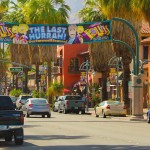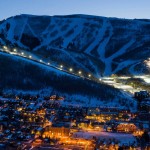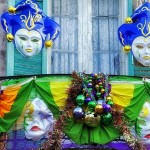THERE’S GOLD IN THEM THAR HILLS! I’m referring, of course, to the hills along California’s historic highway 49 often referred to as Gold Rush Country. I’ve always been fascinated by the history of the miners and their quests for gold. So I decided it was high time that I take a road trip through the eastern California countryside to explore the old historic gold towns that were left behind. On this adventure I planned to visit mines, learn some history and even trying my hand at panning for gold. Maybe I’d get really lucky and find gold just like the early prospectors had! You might say I was already coming down with a touch of “gold fever”.
A Bit Of History
I might have dozed off in some of my grade school classes (especially the ones that were right after recess) but not history class! I loved learning about the expansion of Americans into the “wild” west and especially about the California Gold Rush! It just seemed so adventurous albeit very dangerous. I remember learning that gold was discovered in California at a place called Sutter’s Mill, but I was sort of foggy on the rest of the details. So on the drive up to our first destination I thought I’d do some research to refresh my memory and set the stage for our adventure.
It was on January 24, 1848 when James Marshall, who had been working for John Sutter at his mill in Coloma, California accidentally found a few gold nuggets in a stream. The two men tried to keep the discovery a secret but do you think that happened? NO…of course not! When more gold was found along the South Fork of the American River the news spread fast. Soon Americans from all over the country were flocking to California to find the precious metal. It wasn’t long before immigrants flocked to California from all over the world to try their luck at striking it rich.
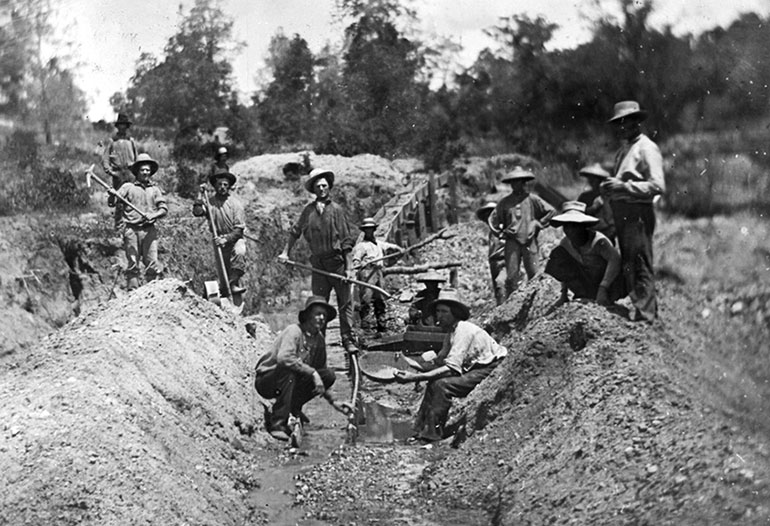
I can totally understand their motivation. Imagine working for six months and finding enough gold to cover six years of your salary! Sounds pretty awesome, right? The earliest prospectors of 1848 enjoyed this kind of success but it didn’t last long. By 1849 EVERYONE had “gold fever” and they were heading out to California in mass amounts. Some struck it rich, but many more left with less than what they had started with. It’s amazing that by 1850, most of the easily accessible gold had already been collected. Prospectors were forced to look for other ways to extract the gold from more difficult locations.
The Gold Rush of 1849 had many effects, some good and unfortunately some really bad, on the land and people of California. One of the inevitable effects was the creation of boomtowns. In some places these towns sprang up almost overnight. Small shanties became bustling cities stocked with saloons, shops and citizens. However when the gold became scarce so did the people. Many of those early mining cities faded into lonely ghost towns. Others however were more prosperous and flourished into quaint communities. We’d be visiting the most important ones so enough talk! Let’s do it already.
The Route Through the Goldfields
Destination 1: Mariposa, CA (Mariposa County)
Below is an wonderful map of the gold rush route. The red line represents highway 49 and the yellow circles are the main points of interest. Why do you think it’s named Highway 49? Well, because the gold seekers were called “forty-niners” as a reference to 1849, the year of the Gold Rush. But I bet you already knew that, right?
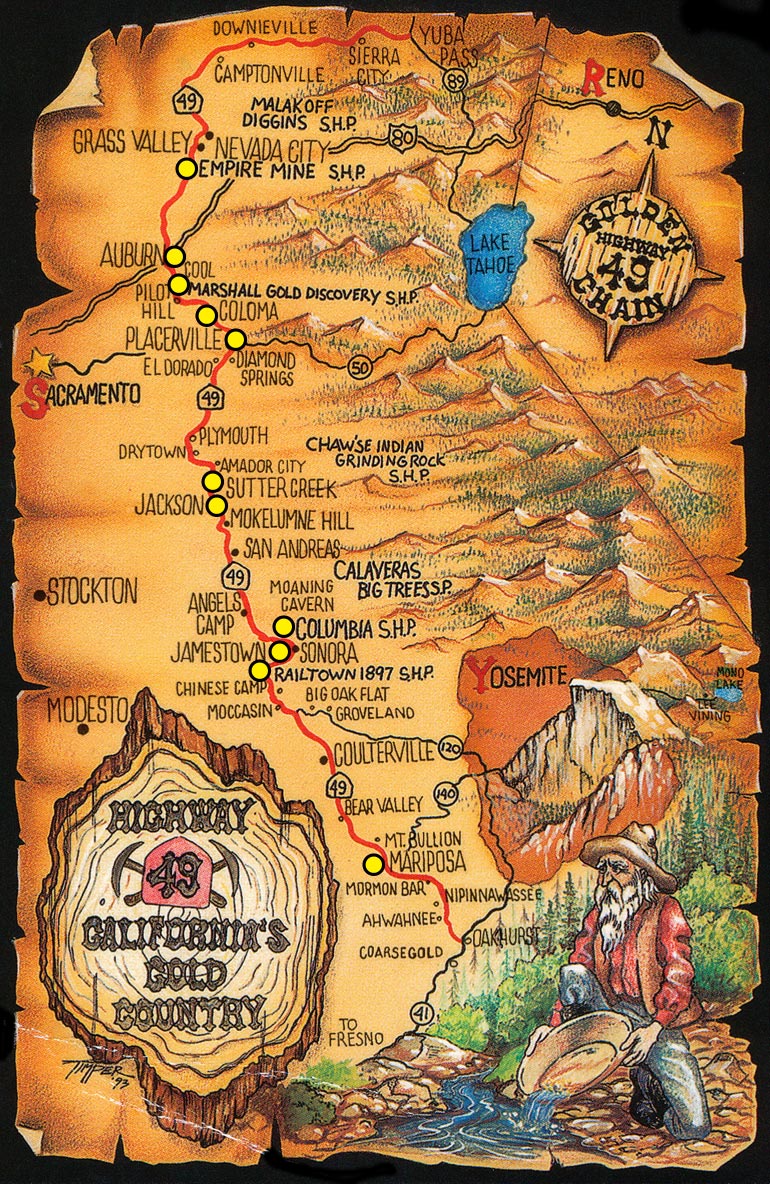
Our adventure begins at the southern tip of highway 49 at a town named Mariposa. After a 5-1/2 hour drive from Los Angeles, checking in to the Miners Inn Motel sounded wonderful. I was hesitant about staying in a “motel” but this one was actually nice and clean. Mariposa, a town rich with gold rush history, is located just 30 miles west of Yosemite National Park. After a good night’s rest we walked around the town and saw old buildings that looked like they had been frozen in time. Just down the street from the visitors center was a museum, a blacksmith shop, old mining structures and rusted carts. I couldn’t wait to see more so we headed out to our next destination, the town of Jamestown.
Climb aboard an authentic steam train
Destination 2: Railtown 1897 State Historic Park, Jamestown, CA
We arrived in Jamestown and drove up the street to Railtown 1897 State Historic Park. This park is so cool! We were going to take a ride on a real historic steam train! As soon as we crossed the tracks to purchase our tickets it felt like we were on the set of a western film. I could see why. The Sierra Railway also known as “The Movie Railroad” was used for over 200 motion pictures, television shows and commercials. The locomotives, buildings and vintage freight and passenger cars are all authentic historical relics of the old west.

As we were waiting for the steam train to arrive at the station we noticed that some elderly women were dressed in period clothing and holding parasols as if they were waiting for the locomotive to bring their loved ones home. Looks like all the volunteers and workers were dressed in clothing reminiscent of the old west. I was buying a bag of fresh popcorn when I suddenly heard the horn from a steam train approaching. The Sierra No. 3 locomotive slowly pulled up to the station then all passengers disembarked. ALL ABOOOOOARD! We handed over our tickets, took our seats and the conductor blew the horn again to signal our departure. Just like that we were off traveling through the Sierra foothills on a 6-mile, 45-minute roundtrip train ride. During the trip the conductor gave us a great history lesson on the the Railtown locomotives and all the movies and TV shows these historical transports starred in such as the classic western film High Noon (1952) starring Gary Cooper and Back To The Future III (1990) starring Michael J. Fox.
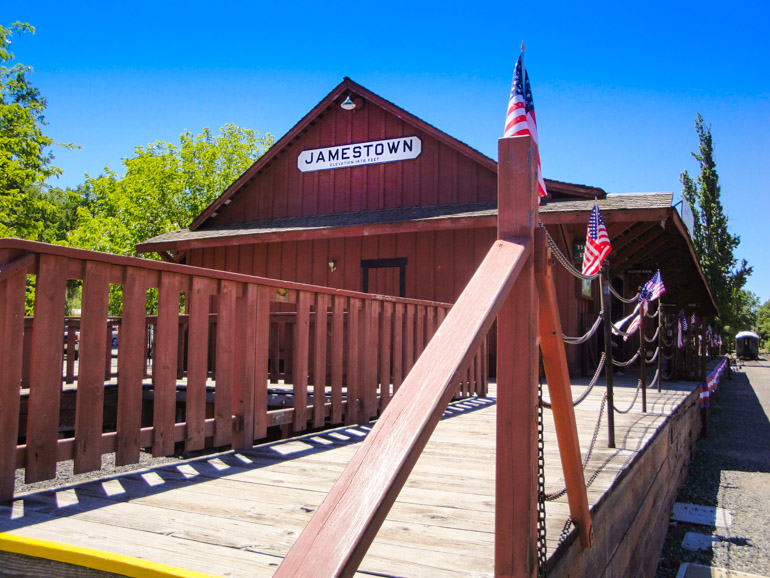
After the train ride, we explored the rest of Railtown’s historic locomotives, buildings and the roundhouse that was built in 1910. It’s sad to know that this state park was almost closed in 2009 and again in 2011 due to California state budget cuts. Fortunately this nostalgic park will remain open indefinitely thanks to the incredible efforts of locals and enthusiasts who helped to raise funding to support it. Long live historic Railtown!

Have A Drink In A Historic Saloon
Destination 3: The National Hotel, Jamestown, CA (Toulumne County)
That was exciting but I was getting a bit thirsty. We decided to head over to Main Street a few blocks away and grab a drink at The National Hotel saloon. Wow…this hotel has been around since 1859 and there are pictures on the wall to prove it! This 19th century bar is exactly the same as it was in the pictures. The only thing that’s changed is time…oh and the bartender. I sat back with drink in hand and wondered what it might have felt like to be a gold miner in the 1850’s drinking at this saloon. I wondered how many shootouts or bar brawls might have occurred right where I was sitting!


I took a restroom break and set a card on the tip of my glass. The card read “I’m taking a break…Please leave my drink alone.” What a cool idea! I hate it when bartenders mistakenly collect your half consumed beverage before you’ve finished it. As I walked away I started thinking that this hotel, being old and all, might have a haunted past. I inquired with the bartender when I returned and he said “Yep, absolutely.” This in fact was one of the most haunted hotels of the gold rush. I’m not really a believer in such things but I do think it’s fun to learn about local legends and lore. The bartender told me I could find the story of their resident ghost on their hotel’s website! I looked it up and sure enough The National Hotel’s website has a page dedicated to Flo, their friendly ghost.
Flora or “Flo” and her fiance Henry were soon to be married and they had both checked in to The National Hotel. The day after Christmas, a town drunk stumbled into the front doorway of The National Hotel and tragically shot and killed Henry as he was descending the steps from his room above. Flo was devastated and sobbed uncontrollably for her lost Henry. Concerned for her safety, the hotel staff entered her room on New Year’s Eve and found her dead from heart failure. She was still dressed in her wedding gown. It’s a sad story but since then hotel guests and staff have reported all kinds of mischievous disturbances. They insist Flo is a friendly ghost. Hotel guests are encouraged to write down any ghostly experiences they may encounter in a journal provided in each room. If you’re more curious about The National Hotel’s resident ghost, you can read more about her here.
Explore a living historic town
Destination 4: Columbia State Historic Park, Columbia, CA (Toulumne County)
Wow..this certainly is no ghost town! Columbia State Historic Park is no doubt the best preserved Gold Rush town in California. Everything is authentic, and still open for business! If you ever wanted to travel back in time to see what a nineteenth century mining town looks like well then visiting Columbia, CA is like hitting the jackpot.

As you stroll down the main road you’ll see a gold panning shop, blacksmith shop, candle maker, indoor wooden bowling alley, carpentry shop, and a wonderful candy kitchen. There’s even a restored Gold Rush-era theater and inn called The Fallon House where they still hold theatrical performances throughout the year. Sidewalk musicians were playing their banjos as people strolled about from building to building. This town is bustling with activity and everything is open for you to walk in and explore!

There is so much you can do at this free…you heard me right…free state park. Guests can enjoy a stagecoach ride through town. Or maybe checkout the old Wells Fargo bank where gold was weighed. If your up for panning for gold, there are staff members that will teach you how to do it. If you’re thirsty you can buy a cold sarsaparilla at the general store or in the 1850’s saloon. Columbia State Historic Park is an amazing place and an incredible way to discover the old west.
Experience wine-tasting in Murphys
Destination 5: Murphys, CA (Calaveras County)
Forgive me for not marking this stop on our map, but we decided to take a little detour on Highway 4 north to the town of Murphys. The Murphy brothers originally set up shop here around 1848. Although placer mining (the mining of stream bed deposits for minerals like gold) in this location was wildly successful, the brothers made far more money as merchants than as miners. It’s possible the spoils of those riches are still evident because the town to me is very reminiscent of Santa Barbara in that it has a certain elegant style. Maybe it has something to do with how many wineries are in the area. The town seems very refined and an excellent place to stop for lunch. You can enjoy a stroll through their beautiful vineyards while sipping on some world class wines.
Descend Into The Mercer Caverns
I unfortunately showed up too late for this adventure (they close at 5pm) but I would highly recommend you try to make it on time if you’re ever in Murphys. As the story goes, Walter Mercer was resting in the summer sun after a long day of gold prospecting. He noticed a small hole in the earth about the size of his fist. He thought it was curious that air appeared to be coming from the hole moving the tall grass just outside. So he went to inspect it, opened up the hole and crawled inside. What he discovered was a labyrinth of beautiful and unusual crystalline caverns. Even to this day there are many unexplored passageways in the caverns that are still being investigated. You can take a tour of the Mercer Caverns and see for yourself an incredible display of the artistry of nature. If you can’t make it to Mercer Caverns, there are other caverns nearby such as the Moaning Cave and California Caverns that can also offer similar adventures.
Spend the night in Jackson
Destination 6: Jackson, CA (Amador County)
There is not much to say about the gold rush town of Jackson at least from my trip. The downtown area was completely deserted except for a few local drunks that were hanging around outside of the town’s saloon. Just like old times, eh? We were looking for a good place to find food and it seemed the entire community was not in the old part of town at all but at a place down the street called Mel’s Diner. It was so noisy in this joint and everyone seemed to know everyone else. The adjoining sports bar was even more crowded probably because everyone was watching a boxing match on the TV’s. It definitely seemed like the people of Jackson where a close knit community. We stayed that night in The Jackson Lodge. There’s really nothing good to recommend about this place. The accommodations were very rugged. For what it’s worth Jackson was still a good location to end our journey for the day and rest our weary bones.
I don’t mean to offend anyone especially if your from Jackson, CA. I’m sure there may be plenty of things to do around town. I just didn’t see them. I heard there is a nearby mine called Kennedy Gold Mine that may be worth looking at. Apparently it’s one of the deepest mines, but there were so many other mines we decided to skip this one.
The Old 49 Highway Detour
The original highway went through towns such as Sutter Creek and Amador City but because of traffic the highway bypass was created. However, you can still take a road off the main highway 49 through these two towns, and you should! The towns are as quaint as expected. You’ll find lots of cute businesses, antique shops, museums and historic houses. We ate at a fantastic place for breakfast called Thomi’s Coffee & Eatery where the french toast was to die for!!!
Pan For Gold Like A Miner 49’er
Destination 7: Sutter Gold Mine, Sutter Creek, CA
At Sutter Gold Mine, as with most gold mine’s along the 49er highway, you can pan for gold. Sluice boxes are conveniently set up outside the gift shop and gold pans are provided. All you have to do is buy your own bag of Gold Ore. You can pay about 5 bucks for a bag that should yield between 5-10 flakes. Or you could pay more for larger nuggets. Either way you’re guaranteed to find gold. An expert miner will help teach you the technique to successfully pan for gold. Well since I’m guaranteed to find gold I thought I’d give it a try.

I can imagine how frustrating it would have been to not find anything day after day, and yet still retain a glimmer of hope you might find a nugget that could make you rich. After several minutes of panning, I found my guaranteed gold flakes. After placing them into a small souvenir vile, we stepped into the Sutter Gold Mine theater to watch the deeply moving historical documentary “The Gold Rush” narrated by John Lithgow. It’s such a good film but the IMDB website describes it best.
“This award winning program traces the epic saga of the bold adventurers who profoundly changed a young nation and redefined the American dream”.
The Sutter Gold Mine tour offers visitors a unique experience of traveling down into a real working gold mine. Each of us was given a hard hat that we would be required to wear while in the mine. We then boarded a small vehicle and away we went deep down into the earth. Our tour guide taught us about the exhibits and tools that had been set up along the main mineshaft. When the vehicle stopped, we carefully got out and were lead to a safe room where we learned what life was like for the mine workers in the mid 1800’s. We also learned about the most modern methods miners are using to mine gold. Can you believe that only 30% of the gold was excavated from the mines during the 1800’s and there is still over 70% of it embedded in the rock cores? That’s why mining operations have resumed and mines like Sutter Creek are open for business once again. We filed out of the room to climb a metal staircase that led us to different mine chambers. Our guide pointed his flashlight right over our heads to the low rock ceiling. OMG there was a huge gold vein right in front of our eyes! We were told that trying to excavate gold veins like this one could be disastrous which is why it was still there. Apparently there was water also running above that rock so if the rock was opened, it could flood the mine potentially killing any miners below it. It was a fascinating tour and our guide was very knowledgeable since he had been working in mines like Sutter Creek for 6 years.
Now I’m no expert but I did learn a thing or two about panning for gold. So should you find yourself with some gold ore, follow the steps below:
How To Pan For Gold
- 1. Dump placer sand into a gold pan.
- 2. Fill pan half full with water and shake pan to settle gold. Gold is heavy and will sink to the bottom.
- 3. Tip pan slightly forward, spilling a little water and sand out.
- 4. Pick up more water, shake pan and repeat #3 until only a teaspoon of sand remains.
- 5. Hold the pan flat; move it quickly in a circle and stop suddenly.
- 6. Your gold should be separated from the sand and can be removed with tweezers or your finger if it’s dry.
- 7. Fill a small vial with water and touch drop your gold in it.
- 8. Get it weighed, jump up and down, quit your job, buy that yacht, then brag to all your friends.
Visit A City Formerly Named “Old Hangtown”
Destination 8: Placerville, CA (El Dorado County)
The downtown of Placerville seems like a place where the old west certainly meets the modern world. There were plenty of historic brick buildings but the downtown area seemed to be bustling with more businesses than other cities we had visited. We stopped for lunch and noticed lots of RV’s passing through probably on their way to Lake Tahoe since Placerville is at the intersection of the 50 and 49 highway. The town has a curious nickname of “Old Hangtown” but for good reason. Hangtown was the name of the town back in 1849 after three hangings occurred there. Locals felt the name should be changed to something a bit more inviting so in 1854 the name was changed and the city of Placerville was incorporated. The old name is still all over the town though. There are Hangtown restaurants, breweries and even a building with the words “Hangman’s Tree Historic Spot” painted on the outside. Oh and there’s that creepy weird dummy that’s hanging from a noose outside one of the windows.
Here’s Where Gold Was First Discovered
Destination 9: Marshall Gold Discovery State Historic Park, Coloma, CA (El Dorado County)

In the town of Coloma at Marshall Gold Discovery State Historic Park, we saw the actual location where James Marshall first discovered gold on January 24, 1848. We also saw the location of the original Sutter’s Mill along the South Fork of the American River. There is a fantastic sawmill replica in the park not far from the original site. It’s a pretty big mill and I could imagine men working days cutting logs in the great outdoors. We explored each of the historical houses, the blacksmith shop, and the old cabins that make up the town and are right along the 49 highway. When the park is open there are usually demonstrations and exhibits for people to enjoy. I thought for a second about throwing some river sand in a pan and seeing if there was any gold left behind. Eh…probably not.

See the largest miner statue
Destination 10: Auburn, CA (Placer County)

Wow! The statue of the miner in old town Auburn is gigantic! I could literally sit in his gold pan (maybe I should have)! This guy greets you as you frolic through yet another former gold town. Auburn seemed more friendly at night than other towns since many buildings were well lit with strings of those large globe light bulbs. We had dinner at the local pizza brewery Auburn Ale House which looked similar to BJ’s Pizza or a Gordon Birsch restaurant. The drinks were absolutely fantastic! After dinner we headed to the Holiday Inn Auburn. The accommodations were superb (at least for what we had been used to over the last few days). Ah…a jacuzzi and a pool! Now we’re talking.
Walk across a covered bridge
Destination 11: Bridgeport Covered Bridge, Bridgeport, CA (Nevada County)

Supply wagons may have crossed this bridge that connected the San Francisco Bay to the California gold fields and Nevada silver fields, but it was me who was crossing it now. No I didn’t have to pay any toll’s as posted on the bridge entrance. My journey was free. Free to see how it felt to cross the long 229 foot bridge and marvel at what great condition it was still in. I felt totally safe crossing it knowing that there would be no chance I plunge into the raging South Fork of the Yuba River below. The Bridgeport Covered Bridge, built in 1862, is a National and State Historic Landmark and is the longest single-span covered bridge in the U.S.

After signing in at the Visitor’s Center, I noticed a short hike (at least it seemed that way at first) called the Cemetery Loop Trail. At first the trail followed the riverbank, but then strayed away from it. The trail itself seemed to almost disappear and thick wilderness seemed to close in all around me. I began to get a little nervous when I saw the warning signs for mountain lions and rattlesnakes. It got eerily quiet, and just as I was about to turn around and head back, the trail opened up to a large field. In the corner of the field close to the main road was a small cemetery dating back to the mid 1850’s. It mainly holds descendants of the Kneebone, Thompson, and Cole families…all founders of the settlements in this area. BTW…it looks like I wasn’t the only one who was crossing the bridge.

Visit the oldest and richest gold mine in California
Destination 12: Empire Mine State Park, Grass Valley, CA (Nevada County)


Of all the gold towns, you’ll find the most magnificent grounds at the Empire Mine State Historic Park. It should be expected though since this was the most profitable mine in in the history of the gold rush. Let me rephrase that.
“Empire Mine is one of the oldest, largest, deepest, longest and richest gold mines in California”.
Owners of the mine turned the adjoining property into a lavish getaway for the rich (which mostly became their families). They built a gorgeous multi-roomed two story stone and brick cottage to live in. They also built a large hunting lodge and used it for the “ladies conventions”. Of course there was a tennis court for the ladies to enjoy as well. These buildings are spread out over acres of well manicured lush green gardens. Not far from all the lavish accommodations is the source that supplied the family’s income. The Empire Mine is gated off today, but you can still look down into its tunnel and get a feeling for how the miners boarded their shuttle and descended into a dark mine at a speed of almost 600 feet per second. The tool wedged between the rock walls was nicknamed “widowmaker” because many of the men who operated the drill died from illnesses related to inhaling too much dust. And you thought your job was tough!

End Your Trip In Historical Sacramento
Destination 13: Sacramento, CA (Sacramento County)
I hate to end a trip on an unlucky number but then again I never found my big gold nugget so I guess it’s okay. We drove to the state’s capital city of Sacramento for our final stop before returning home. Fortunately we had enough time to explore Old Sacramento State Historic Park which is now a National Landmark. I had no idea that this city had a section of town with old buildings that are just as well preserved as the ones we visited along highway 49! We bought an ice cream then strolled down the old street admiring the old buildings. It might sound cheesy but the real gold was not what I might find in the ground. It was the continuing historical preservations that have lasted for more than 100 years in this beautiful state of California. But I’m still keeping my eye out for that gold nugget!


